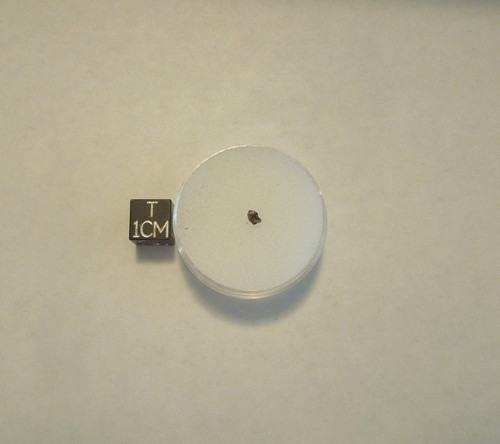On December 20, 2020, a bright fireball lit up the sky over a remote area of the western Algerian Sahara. Within a few days, the first meteorites were recovered by local hunters. Due to the dangerous military situation on the ground in Algeria, it took over a year for samples to find their way to labs for analysis.
At first glance, the meteorites looked like typical freshly-fallen H chondrites. But, upon cutting and closer examination, sizeable purple halide crystals were found inside the matrix. This is only the third known meteorite to contain extra-terrestrial salt (Zag and Monahans being the other two). The official classification is "H5, anomalous" - one of only 5 known to exist. Due to a lack of proper documentation for the recovery, this fall was officially classified as a "find, possible fall", but it is undoubtedly a "witnessed fall".
Refer to the photo. The black centimeter cube is shown for scale and is not included. You are purchasing a single small fragment similar to the one shown. Your fragment may or may not have a small bit of fusion crust on it. Not all fragments have fusion crust. If I have a fragment with crust, that will be the one you receive, but I cannot promise that any individual fragment will have crust on it. Your purchase will include a labeled gemjar for safe storage.
From the Meteoritical Bulletin entry on SEH 001 :
Sidi El Habib 001 (SEH 001) 24.298°N, 3.745°W
Bordj Badji Mokhtar, Algeria
Find, possible fall: 2020 Dec
Classification: Ordinary chondrite (H5, anomalous)
History: On December 20, 2020, a bright fireball was witnessed in western Algeria by people prospecting for additional material of the Erg Chech 002 meteorite. After searching for two days a group of fresh fusion crusted stones was found at a location close to the Mali border at 24.298°N, 3.745°E and near a well named Hassi el Kounti. All of the collected material was purchased by Ben Hoefnagels in May 2021 from two Moroccan dealers.
Physical characteristics: Fresh fusion crusted stones with broad and shallow regmaglypts. Largest stone is 1.1 kg. Broken surface shows light-colored clasts in a matrix of light grey material. This grey material contains relatively abundant, to 1-mm, bright blue to purple grains of halite. Density of a 34 g stone comprising the two lithologies is 3.77 g/cm3, determined by the glass bead method. Magnetic susceptibility log χ (× 10-9 m3/kg) = 5.17.
Petrography: (L. Garvie, ASU) A sawn and polished 8 × 6 cm slice shows subhedral light-colored clasts, to 2 cm, in a light-grey matrix. Purple to blue crystals are locally abundant in the light-grey matrix: a powder XRD pattern of these crystals is dominated by reflections for halite and minor sylvite. Well-formed, though sparse, chondrules scattered through-out the clast and matrix lithologies, 601±403 micron (n=26), and separated by coarse-grained mineral and chondrule fragments. Chondrules dominated by PO, rare BO, and rare RP. Some unusual chondrule types present including one dominated by olivine-feldspar-chromite in the matrix lithology, and several Na-Al-Si-rich chondrules in the light-colored clast. Element mapping shows the NaCl to be present only in the grey-matrix lithology at all spatial scales from the mm-sized grains to sub-μm inter-grain films. The halite and sylvite are anhedral, though internally show well-developed cubic cleavage, and give the appearance of euhedral grains. A typical 4 × 4-mm-sized area of the halite-rich matrix contains ~8 areal% NaCl. High-resolution BSE images of the matrix show local regions with bright intergranular "veins" that are rich in Fe-Ni-Cl with little to no Na. A 1-mm subhedral ferroan sphalerite with a rim of troilite occurs in one of the probe mounts from the matrix lithology. The grain contains ~23 wt% Fe, close to the composition for rudashevskyite. Examination of the hand specimens shows several ferroan sphalerite grains in the matrix lithology: XRD of one of the grains confirms the sphalerite structure. Interchondrule feldspar is variable in size, though typically 5 to 20 μm. Merrillite and apatite are common in the clasts as grains to 0.5 mm (total 0.2 areal%). Some merrillite grains have veins and mantles of apatite. Element mapping of the light-colored clast shows several Cl hot-spots that are rich in Fe and Ni, but lack Na. Apatite and merrillite grains are more sparse and smaller in the matrix material.
Classification: H5 (breccia, anomalous). The pervasive presence of primary alkali halides in this meteorite is anomalous, and previously recognized only in Zag and Monahans (1998).





